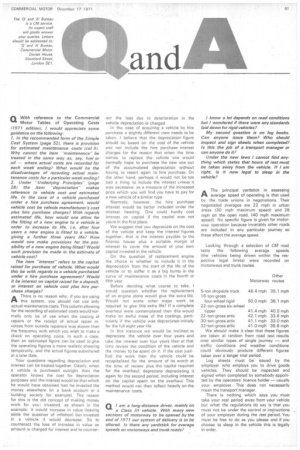Q With reference to the Commercial Motor Tables of Operating Costs (1971 edition), I would appreciate some guidance on the following..
Page 53

If you've noticed an error in this article please click here to report it so we can fix it.
1, In the recommended form of the Simple Cost System (page 52), there is provision for estimated maintenance costs (col 91. Why cannot the item "maintenance" be treated in the same way as, say, fuel or oil where actual costs are recorded for each week ending? What would he the disadvantages of recording actual maintenance costs for a particular week ending? 2. Under "Underlying Principles" (page 28i the item "depreciation" makes reference to vehicle cost and estimated life, In the case of a vehicle purchased under a hire purchase agreement, would vehicle cost be vehicle manufacturer's cost plus hire purchase charges? With regards estimated life, how would one allow for the fitting of a new engine to a vehicle in order to increase its life, i.e. after four years a new engine is fitted to a vehicle, giving a further three years life? How would one make provisions for the possibility of a new engine being fitted? Would such provision be made in the estimate of vehicle cost?
The item "interestrefers to the capital raised for purchase of vehicle. What would this be with regards to a vehicle purchased under a hire purchase agreement? Would it be interest on capital raised for a deposit, or interest on vehicle cost plus hire purchase charges?
AThere is no reason why, if you are using this system, you should not use only actual maintenance costs. This column allowing for the recording of estimated costs would normally only be of use when the costing of repairs or the receipt of actual repair invoices from outside repairers was slower than the frequency with which you wish to make a check on operating costs. In such a case, then an estimated figure can be used to give the operating figures a more realistic showing temporarily, and the actual figures substituted at a later date_ Your questions regarding depreciation and interest can be treated together. Clearly, when a vehicle is purchased outright then the operator knows the cost for depreciation purposes and the interest would be that which he would have obtained had he invested the money elsewhere (in a bank account or a building society for example). The reason for this is the old concept of making money work for you: invested, as shown in the example, it would increase in value cleaving aside the question of inflation) but invested in a vehicle it would decrease. So to counteract the loss of increase in value an amount is charged for interest and to counter
act the loss due to deterioration in the vehicle depreciation is charged In the case of acquiring a vehicle by hire purchase a slightly different view needs to be taken. I believe that the depreciation figure should be based on the cost of the vehicle and not include the hire purchase interest charges for the reason that when the time comes to replace the vehicle one would normally hope to purchase the new one out of the accumulated depreciation without having to resort again to hire purchase. On the other hand, perhaps it would not be too bad a thing to include the interest unless it was excessive, as a measure of the increased price which you will find you have to pay for a new vehicle of a similar type.
Normally, however, the hire purchase interest would be better included under the interest heading. One could hardly cost interest on capital if the capital was not yours in the first place.
We suggest that you depreciate on the cost of the vehicle and keep the interest figures together, that is .the interest payable to the finance house plus a suitable margin of interest to cover the amount of your own capital invested in the vehicle.
On the question of replacement engine the choice is whether to include it in the depreciation from the start of the life of the vehicle or to suffer it as a big hump in the curve of maintenance costs in the fourth or fifth year.
Before deciding what course to take. I would question whether the replacement of an engine alone would give the extra life. Would not some other major work be required to give this extra life? If a complete overhaul were contemplated then this would make an awful mess of the castings, particularly if the vehicle was depreciated initially for the full eight year life.
In this instance we would be inclined to depreciate the vehicle over four years and take the interest over four years then at that time review the condition of the vehicle and the money to be spent on it. If the cost justified the work then the vehicle could be recapitalized for the amount of its worth at the time of review plus the capital required for the overhaul: depreciate depreciating it again for the second period, including interest on the capital spent on the overhaul. This method would not then reflect heavily on the maintenance costs.
































































































